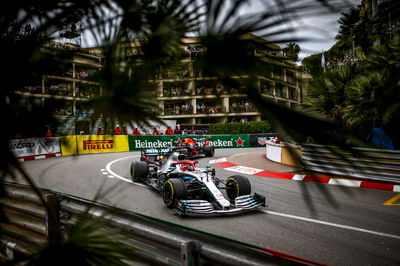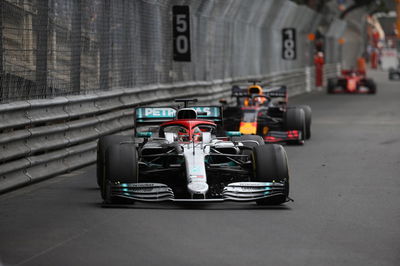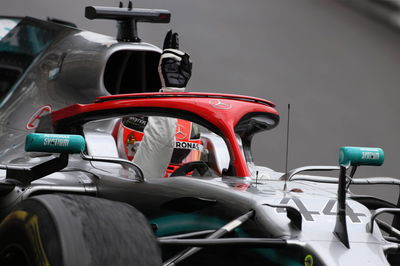Race Analysis: How Hamilton held on to win his hardest race
For all of the criticism the Monaco Grand Prix may receive in terms of the on-track spectacle it offers, Sunday’s race was proof of how tense and dramatic a race without overtaking at the front of the pack can be.
“I don’t know if it was boring for you, but it wasn’t boring for me in the car,” Lewis Hamilton said not long after his victory, still surprised by his success after holding on for 67 laps on a fading Medium tyre as Max Verstappen crawled all over the rear of his Mercedes.

For all of the criticism the Monaco Grand Prix may receive in terms of the on-track spectacle it offers, Sunday’s race was proof of how tense and dramatic a race without overtaking at the front of the pack can be.
“I don’t know if it was boring for you, but it wasn’t boring for me in the car,” Lewis Hamilton said not long after his victory, still surprised by his success after holding on for 67 laps on a fading Medium tyre as Max Verstappen crawled all over the rear of his Mercedes.
It was a hard-earned win at a track which Hamilton has struggled to tame over the years, this being only his third victory. At the end of an emotionally-charged weekend for both Hamilton and Mercedes following the death of non-executive director Niki Lauda, he was given one of the more challenging wins of his 77 to date in Formula 1.
It could have been oh-so-easy for Hamilton and Mercedes in Monaco, something the Briton recognised himself post-race: “If it hadn’t been for the Safety Car, it would have been a much easier race for us. I think I would have got to Lap 20 or 22 or whatever it was and stuck on another set of tyres and probably cruised to the finish, in a more relaxed environment.
“It wasn't boring for me in the car. I appreciate a tough race. Ultimately I think as an athlete, you always want the toughest battles.”
The Safety Car triggered by Charles Leclerc’s tyre failure caused by an ambitious – but, as his pass on Romain Grosjean the lap before proved, not impossible – attempt to overtake Nico Hulkenberg at La Rascasse scuppered what looked set to be a straightforward race for Mercedes. Valtteri Bottas lost second place to Max Verstappen after their clash in the pit lane, with the need to pit twice in two laps costing him another position to Romain Grosjean, leaving Hamilton exposed at the front.
Coming around 10 laps before the anticipated window for pitting, Mercedes stuck to its original plan of running Hamilton on a fresh set of Mediums instead of going for the more durable Hard compound. (It had planned to do the same with Bottas). But with both Verstappen and Vettel on Hards, they would easily be able to make it to the end without pitting, with the white-ringed compound comfortable able to manage a full race distance.
While Hamilton dropped Verstappen out of DRS range on the restart, the Red Bull driver clawed it back to sit within a second of the leader on Lap 17 after just three laps of green flag running. He would spend just three of the remaining 61 laps over a second away.
“He literally covered my whole mirrors!” Hamilton said of Verstappen. “I was able to get out of the last corner and pull a bit of a gap to Turn 1, through Turn 3, my right-side tyres were OK. Then once we got to Turns 4, 5, 6, 7, 8, I had nothing.
“I was putting the brake balance rearwards, opening up diffs, trying to get the car turned. I could see him carrying a lot of speed in, and the harder tyre was much more resilient. I could see it opening on his tyre, and I was thinking I hope he’s going to run out of tyres at some stage, but he didn’t.”

Verstappen just kept on pushing, with Hamilton flagging up concerns about his tyres very early in the stint. He was told to just keep on going, but time and time again he snapped back to his engineers, asking if they were sure about the call.
“With 38 laps to go, I’ve got no tyres left, and I’m thinking there is no way with the grip that I have or the pace that I have to do, that I’m going to make it,” Hamilton explained.
“It’s a horrible feeling to have that, because the thought of having to do another stop obviously means we wouldn’t win the race. I thought I’m not coming in whatever the case, I’ll drive on those tyres until they blow up!”
And so he did. Hamilton kept on pushing as much as he could, dropping his lap times to a manageable level – sometimes so slow that even Williams drivers Robert Kubica and George Russell were running quicker at points – in a drive reminiscent of Daniel Ricciardo’s effort last year. It’s the old philosophy of winning the race as slowly as humanly possible.
The Loews hairpin was where Verstappen kept getting closest to Hamilton, something he clocked onto quickly: “I was trying to cover that whole area, tip-toeing around and positioning myself so I could hopefully get a good exit.” But while Verstappen could keep running close to Hamilton through the right-hander at Portier, the Mercedes would then pull out a gap again by the time they’d exited the tunnel and arrived at the Nouvelle Chicane, scuppering his chances of pulling a pass.
But after a call to turn up his engine, Verstappen – who despite having a five-second time penalty would have given it a damn good shot at pulling that gap out – sensed an opportunity with three laps to go. From a long way back, Verstappen sent it up the inside, seemingly catching Hamilton by surprise as he drifted across to defend very late. The pair touched, but both could continue with no damage caused.
“I couldn’t really plan the move because I was always so close at the hairpin, but all the time out of Turn 8, I just lost the momentum,” Verstappen explained.
“At one point I just thought let’s have a go and see what happens. We had this little touch but under braking. You normally don’t look in your mirrors already, and they are also difficult to see through. There was no-one to blame. I don’t think there was any damage.”
Hamilton also brushed off the move, as did the stewards, who swiftly confirmed after the race that no action would be taken for the incident. No harm done at all.
Hamilton’s emotions may not have been as animated as they were on Saturday after he took pole, but after the race, it was clear just how much this win meant to him. He seemed exhausted and exasperated by what he had just achieved, dragging his car home when its tyres were cooked.

So why did Mercedes go for Mediums instead of Hards with Hamilton? He had a fresh set of Hards available, and with few strategy options available, surely it was the safer call?
“What we’ve calculated is if we changed to the Medium on Lap 15 or 16, it would make it to the end with the right management,” Mercedes team boss Toto Wolff explained. (Hamilton pitted on Lap 11.)
“Being in the lead, that was a pretty straight strategy. It didn’t even seem like a huge stretch.
“We realised, with 20 laps into the race, that on the left front, some graining appeared. He started to complain about the understeer from the graining and it was clear that it would get very, very difficult to make it to the end.
“We had some discussions about the tyre lasting another 40 laps, and I was reminded that it was only 20 laps on a normal circuit. So, I calmed down a bit! But everybody knew that it’s going to be a huge stretch.
“I believe that probably 20 laps to the end, he had like zero percent rubber left on the tyre. He had understeer in the low speeds. You could see it around Loews, the car wouldn’t turn.”
Wolff did not downplay the error, though, even if it is one only obvious through hindsight. “It was obviously the wrong call,” he said. “We thought the tyre would make it to the end and it didn’t.
“But he saved us. His driving really saved us.”
It was a minor slip up, something Mercedes rarely does. But put together the difficulty of passing in Monaco, and a driver of the special quality of Lewis Hamilton, and you can see why the team got away with it.










